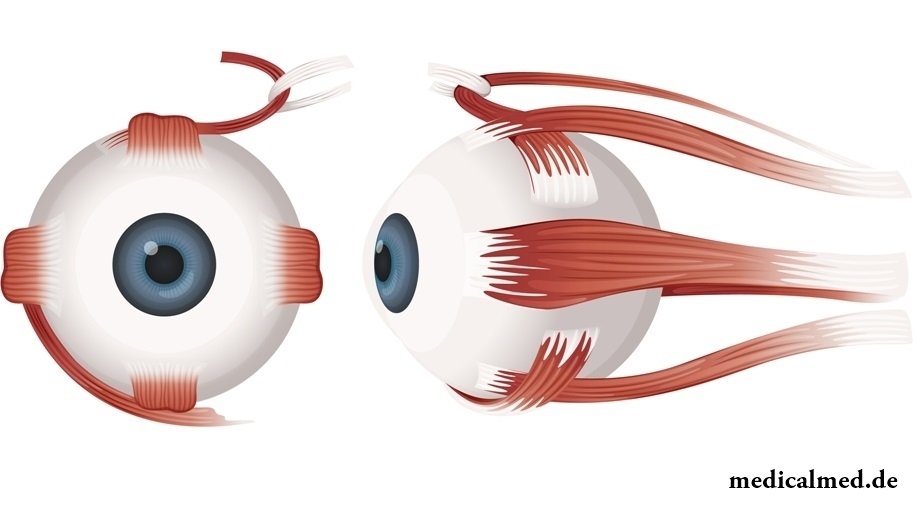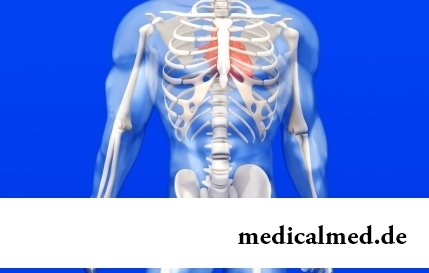





Eye muscles
Eyes of the person are in an environment of six eye muscles: four straight lines (upper and lower, lateral and medial) and two slanting (upper and lower).

All muscles of an eye, except lower a braid, begin from the tendinous ring located in the thickness of an eye-socket and kpered, forming a cone-shaped muscular funnel disperse. All eye muscles, except upper a braid, are attached to a sclera at once.
The upper oblique eye muscle goes to the cartilaginous block forward. At the block it turns into a sinew and, having passed through a block loop, sharply changes the direction of the movement. Under an upper direct eye muscle it gets into an eyeglobe sclera behind the equator.
The lower oblique eye muscle begins from an internal wall of an orbit and, bending around an eyeglobe, connects to a sclera behind the equator.
The upper oblique eye muscle is innervated by a block nerve, an outside direct eye muscle – the taking-away nerve, and all other muscles are innervated by a third cranial nerve.
Outside muscles of an eye are placed in such order (on increase): the lower oblique eye muscle (thinnest), then an upper slanting, upper straight line, the lower straight line, an outside straight line and an internal straight line – the most powerful muscle.
Functions of muscles of an eye
On the action muscles of an eye are divided into the following groups:
- the lifting muscles (the lower slanting and upper straight line);
- abductors (slanting and outside straight line);
- adductors (lower and internal, upper straight lines);
- the lowering muscles (upper slanting and lower straight line).
As well as skeletal muscles, muscles of an eye can be reduced without shortening (isometric contraction) or with shortening (isotonic contraction).
Thanks to isotonic contraction of an outside direct eye muscle the eyeglobe turns outside. The internal direct eye muscle turns an eyeglobe inside. The lower direct eye muscle turns an eyeglobe down, and an upper direct muscle – up. The lower oblique eye muscle turns an eyeglobe up and outside, and an upper oblique muscle – down and outside.
During bystry movements of an eye eye muscles are reduced with a force of 0,11-0,13 kg. At turn of an eyeglobe the muscle is reduced by forty degrees with a force of 0,045 kg.
The reasons for which muscles of eyes hurt
The frequent reason for which muscles of eyes hurt is their overfatigue. Besides, eye pain can arise because of a scratching of an eye surface contact lenses or because of use of incorrectly chosen glasses. Sometimes muscles of eyes as a result of an overstrain of facial muscles hurt.
Besides, eye pain can be connected directly with eye diseases – a uveitis, conjunctivitis and others. In this case pain quite often is followed by a febricula (nausea, a headache) and a vision disorder.
Training of muscles of eyes
The most efficient means for strengthening of muscles of eyes – fortifying occupations in a combination to special exercises for muscles of eyes.
In house conditions it is recommended to include in training occupations breathing exercises, walking, the movements by hands, exercises for a shoulder girdle, exercise for muscles of an eye, exercise for muscles of legs and a trunk, self-massage of a neck and eyes, relaxation exercise.
The training of muscles of eyes has to include exercises for outside and internal eye muscles.
Training of outside eye muscles:
- in a sitting position slowly to transfer a view from a ceiling of a floor and back, then from left to right and back (to repeat till 10-13 times);
- to carry out rotations by eyes diversely (to repeat 4-7 times), and also frequent blinking within 15-20 seconds.
Training of internal eye muscles:
- on a windowpane to attach a tag of a round form at the level of eyes with a diameter of 4-5 mm at distance of 30 cm from eyes;
- to translate a view of a tag, of any remote subject behind a window.
Exercises for strengthening of muscles of eyes should be carried out twice a day. In the first two days – within three-four minutes, on the third and fourth – five minutes, in the next days – ten minutes.
For prevention and treatment of a myopia (short-sightedness) by the American ophthalmologist U. Bates the set of exercises for each type of a visual disturbance separately, and also general exercises, effective was offered at exhaustion of eyes and at any vision disorders.
Bates considered that points, improving visibility, worsen blood supply of eyes and strengthen a visual disturbance and eye tension.
Bates's gymnastics includes a method of a passive relaxation (visualization, a palming), a method of a dynamic relaxation (solarization, breath and a blinking), a method of the central fixing (analytical watching, glances, rocking and movement, reading a small print, rocking).
Techniques of recovery of sight of Norbekov and Zhdanov, slightly supplementing and altering, copy a technique of the ophthalmologist U. Bates.
In our intestines are born, millions of bacteria live and die. They can be seen only at strong increase, but if they gathered, then would be located in a usual coffee cup.

An eye of the person daily experiences considerable strain. The problem of preservation of sight is for many years directly connected with a question снабж...
Section: Articles about health
To look healthy and means well-groomed not only to be pleasant to people around, but also to feel strong, sure and taken place. Specialists in the field of cosmetology quite often note that whether not all women are able to look after skin...
Section: Articles about health
Is told about advantage of domestic animals for development of the child much. But many parents nevertheless do not hurry to bring pets as are afraid that they can do harm to health of children. What troubles can really trap kids and how to make joint life of a family and domestic animals comfortable and safe?...
Section: Articles about health
For the person who daily since morning gathers for work it is very important to wake up vigorous and ready by day of work. On most...
Section: Articles about health
Cold – a state known to everyone which is followed by cold, cough, high temperature, a pharyngalgia. Often the first that we begin to do in hope again to become healthy – to accept medicines which are not always harmless, then...
Section: Articles about health
The phenomenon of improvement of a condition of the patients at administration of drugs who are not containing active agents, so-called effect of placebo is known long ago. At the end of the 18th century the American doctor Perkins began to treat people the "miracle" sticks made of alloy of steel and brass. Was for several minutes to press such subject enough to a sore point that it became much easier for the patient. Having suspected Perkins of charlatanism, his colleagues tried to repeat "miracle" by means of sticks, steles...
Section: Articles about health
Each person has easy indispositions which he transfers "standing", trying not to ask for medical care. Argu...
Section: Articles about health
What woman does not dream of a beautiful and thick hair? While physicians developed difficult schemes on hair transplant, in the industry of hairdresser's art a few years ago there was a sensation – methods of hair extension appeared. It would seem, dreams came true...
Section: Articles about health
Phobia – the persuasive fear of a certain contents shown in a specific situation against the will of the person. Concepts of a phobia and fear are similar, however if the fear is natural protective function of mentality, then the phobia is its deviation. So the person can feel the unaccountable, baseless fear accompanied with neurotic symptoms (perspiration, a shiver, a fever) before any ordinary phenomenon – for example, a trip by the subway or a simple dog....
Section: Articles about health
The immunity role in growth of the child is invaluable. The proteins-immunoglobulins produced by immune system preserve the child against diseases...
Section: Articles about health
Small appetite at the child – the complaint which pediatricians should hear practically from each mother. Most often it is carried to the category of children's whims, however the refusal of food in certain cases can be to alarming symptoms therefore it cannot be ignored....
Section: Articles about health
The climax, or menopause is the normal process of the termination of genital function of the woman which is followed by serious hormonal changes in an organism. Usually the menopause begins at the age of 50-55 years, but characteristics of this process are very individual. Factors of earlier approach of a climax are irregular sex life, numerous abortions, addictions, existence of endocrine, autoimmune and gynecologic diseases, frequent stresses and excessive hobby of diets...
Section: Articles about health
Since the moment when the child becomes a school student, his sight begins to be exposed to the strengthened loadings which are supplemented viewing...
Section: Articles about health
80% of women at least once to lives complained of discomfortable feelings to breasts, consolidations and nagrubaniye. These are mastopathy symptoms. The mastopathy is characterized by change of a ratio between ferruterous and connective tissue tissues of mammary glands. It can bring...
Section: Articles about health
All know that self-treatment is dangerous. However absolutely it is almost impossible to do without it. Rate of modern life does not allow to handle each small trouble to the doctor and information on ways of independent delivery of health care is quite available. Means, all of us have only one: to learn to give this help competently and in those limits in which it is possible for the person who does not have vocational education....
Section: Articles about health
White teeth and the Hollywood smile – a dream of many people. Long time was considered that a plaque on teeth and change of their color – destiny of those...
Section: Articles about health
It would seem, about it there can be no disagreements: water is necessary for a human body for normal life activity, and about how and when it should be drunk, all know. It turned out that the situation is not absolutely so: for many years occur ве...
Section: Articles about health
Tuberculosis – a serious infectious disease which development is caused by mycobacteria (Koch's bacilli). The illness is known from an extreme antiquity. Long time fight against it was considered as ineffective. Quite often the disease affected the whole families, and mortality from it was very high. It became the reason of emergence of a set of delusions concerning transmissibility and a possibility of treatment of tuberculosis....
Section: Articles about health
One of the major chemical processes happening in a human body are oxidation reactions. They go with participation of fats...
Section: Articles about health
Eyes – one of the most vulnerable areas on a face therefore age changes concern them first of all. Whether it is possible to keep look youth for many years and what procedures are offered for achievement of this purpose by cosmetologists? And maybe, only thing of a vari...
Section: Articles about health
Many of us, probably, noticed more than once that from intellectual loadings at some point the brain as though "overheats" and "assimilation" of information is strongly slowed down. Especially this problem urgent for persons of age becomes more senior than fifty years. "Already badly I think", "the head will burst now", "memory as if is disconnected" - here that wants to be told at the time of information overload....
Section: Articles about health
It is difficult to revaluate importance of kidneys for an organism. These bodies not only perform work on purification of blood of decomposition products and выв...
Section: Articles about health
All diseases from nerves – in this joke a big element of truth, are said by doctors. Constant stresses lead to decrease in protective forces of an organism, and it becomes vulnerable for a set of diseases. It is wrong to think that the stress is a problem of the present. Life of people and hundred...
Section: Articles about health
It is known that the person for 80% consists of water which participates in all processes of an organism. The person loses liquid daily – as a result of sweating, breath, an urination, and its insufficient completion due to various reasons can lead to dehydration of varying severity. Dehydration (dehydration) occurs already in case of loss of liquid in number of 1% of body weight and can result both in easy thirst, and by the death. In time to notice signs обезвож...
Section: Articles about health
The pine is one of the most widespread plants of our woods. Its needles and pitch not without reason called by "gallipot", since ancient times испол...
Section: Articles about health
All the known slogan "Protect Men!" arose not from scratch. In a sense, the nature created men much less adapted for vital disorders, than it seems at first sight. Statistically, men are ill more often...
Section: Articles about health
For many women the word "fat" sounds as a sentence. In aspiration to an ideal figure they try to exclude, first of all, from the menu all dishes containing fats without having at the same time a clear idea of a role of these substances in exchange processes, and of effects for health with which food restrictions of this sort are fraught. For what the human body needs fats and as their deficit in a diet is shown, we also will try to find out....
Section: Articles about health
